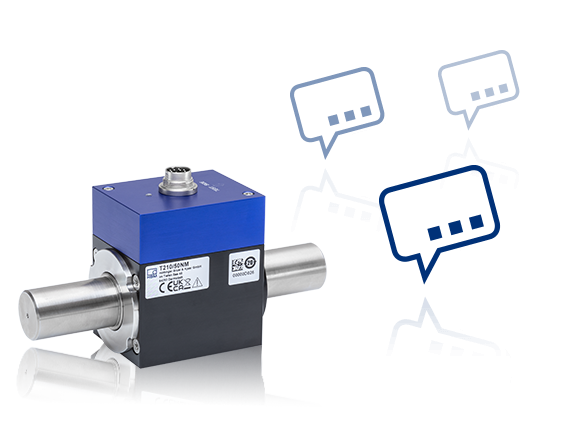Shaft torque transducers are true all-rounders used in a large variety of technical applications ranging from engine test beds to production lines. This FAQ includes important questions and answers relating to installation and setup, function, strengths, and limitations.
Shaft Torque Sensors: Facts and Features
What Is a Shaft-type Torque Transducer?
A shaft-type torque sensor, also referred to as a torque measuring shaft, is a measuring instrument used to measure torque. Generally, torque transducers are used in test benches, production lines or other technical assemblies to measure the torque that is applied there.
How Does a Shaft Torque Transducer Work?
Most torque transducers are based on strain gauge technology. The basic design consists of a shaft that deforms by a minimal amount when external loads are applied, and this deformation is measured and processed. Reliable measurements are possible as it is known how much the shaft deforms in relation to the known loads. If torque is involved, the applied load generates a torsion, i.e. a twisting of the measuring body.
What Is the Torque Measuring Shaft Made up Of?
In simple terms, the torque transducer is made up of three main components or areas:
- A shaft, also known as the rotor, that is connected into the measurement line, and on which the actual measurement is completed
- Electronic components and circuit boards for signal conditioning and the supply of energy
- A housing, also known as the stator, that encases the shaft and electronics. The housing can also be mounted in the test benc
How Is a Shaft Torque Transducer Installed?
The transducer can, for example, be attached to the test bench via the housing using the holes in the base or side. Precise alignment must be ensured during this process so that the shaft ends of the measurement shaft are aligned with the drive and output shafts of the measurement line. The measurement shaft can alternatively be installed in a suspended position. It is then supported by the drive and output shafts. This solution is more suitable for lower rotational speeds.
What Mechanical Connection Options Are Available?
The measurement shaft must be installed in or connected to the measurement line of the test bench or system. This can either be implemented via positive locking connections, such as interlock systems, square or key connections. On the other hand, there are a large variety of force-fit connections, such as clamped bellows couplings or shrunk-on multiple-disk couplings.
How Can the Measurement Results Be Displayed and Processed?
A downstream electronic system is required as a torque transducer usually does not have its own display. Depending on the application, a simple device with a display can be used to directly show the results, an electronic system can record and process the measured values, or a complex control system can be implemented. The output signals may vary depending on the situation. The output is often a frequency or voltage signal.
What Are the Advantages of Shaft Torque Transducers?
Simple operation together with universal application options provide great advantages. The protected design, with housing around the measurement shaft, is particularly suitable for small measuring ranges. In terms of pricing, measurement shafts are usually more attractive than comparable measurement flanges.
What Are the Disadvantages of Torque Measuring Shafts?
One design-related disadvantage that cannot be avoided is the bearing friction generated when using shaft torque sensors. Generally, the mounting space required for a measurement shaft is slightly longer than that of a measurement flange. Due to their design, measurement flanges are more suitable for very large torques in the kilonewton and meganewton range.
How Do I Choose the Right Torque Measurement Shaft?
This simple question requires a comprehensive answer to ensure that all key aspects are fully covered. It is initially sensible to take the measuring range and maximum expected rotational speed into consideration. It is also helpful to consider the required level of measurement accuracy at an early stage. Environmental temperatures should also not be forgotten. For further clarification of whether a measurement shaft is suitable or not, we recommend looking at the technical data sheet and consulting the mounting instructions. These include further in-depth information.
What Must Be Observed When Replacing Torque Measurement Shafts in Existing Systems?
When replacing shaft torque transducers in existing systems, the geometric dimensions, including the mounting hole pattern, and shaft diameter must be taken into consideration. The signal output must also be compatible or easy to adapt. As torque transducers often have very similar dimensions and voltage and frequency outputs are widely used, usually only few adaptations are necessary, and it is often easy to install a replacement.
